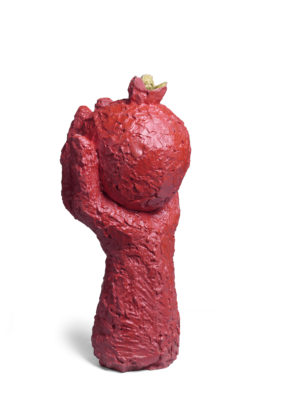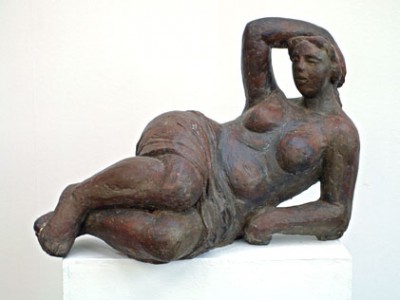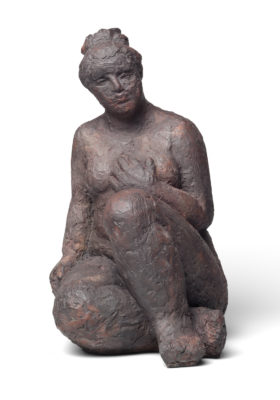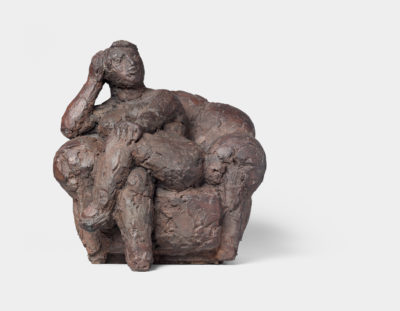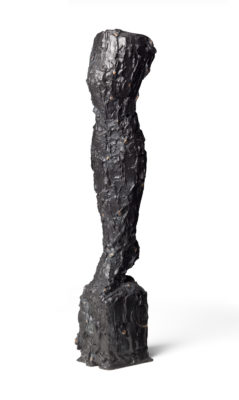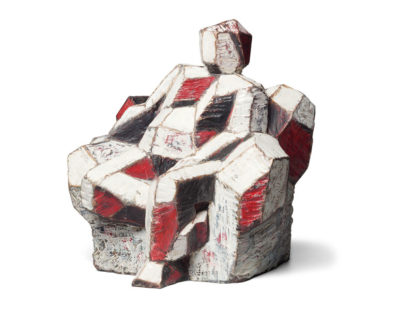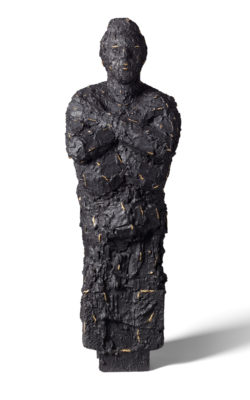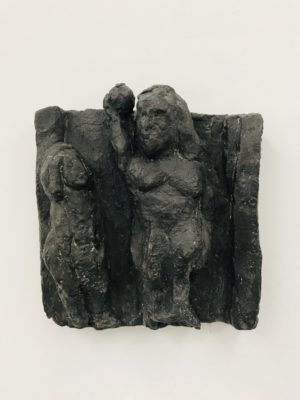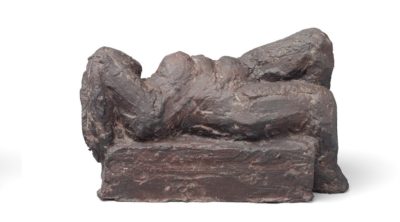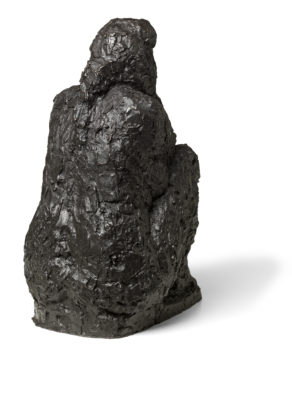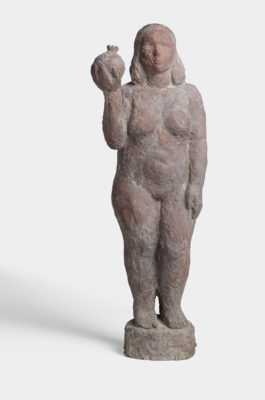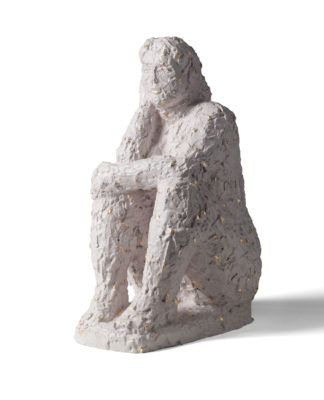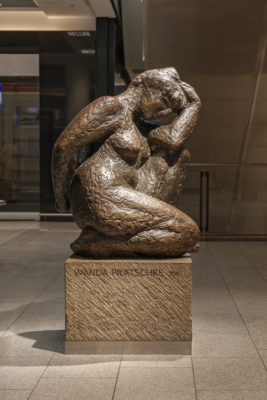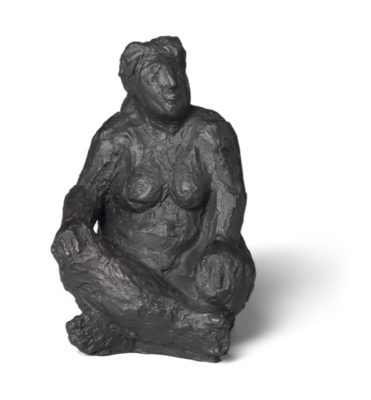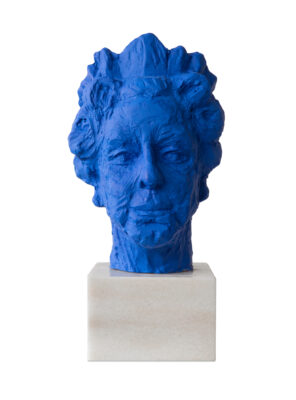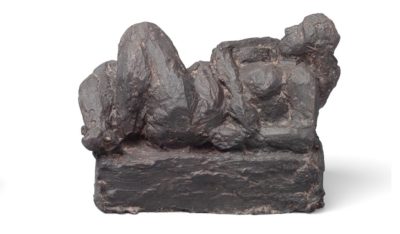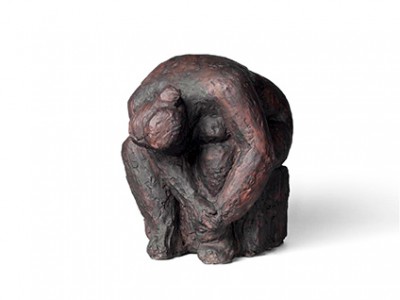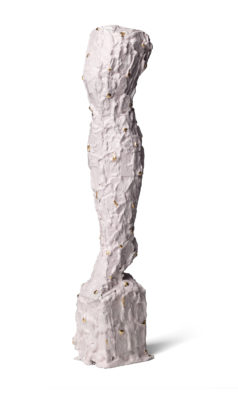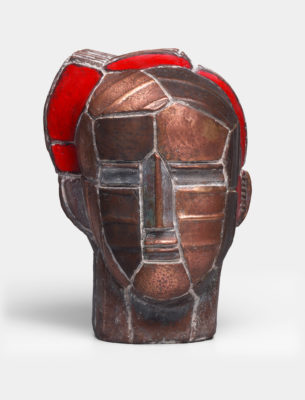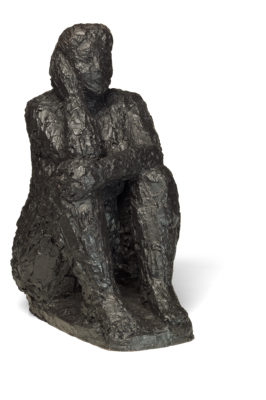Wanda Pratschke
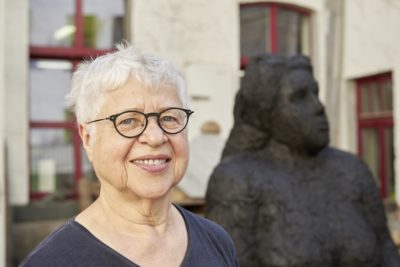
biography
Born in Berlin in 1939
1956 - 1961 Master school for arts and crafts (stage design), Berlin
1961 - 1963 Assistant to Franz Mertz, Städtische Bühnen Frankfurt am Main
1976 - 1979 Städelschule, painting with Prof. J. G. Geyger, sculpture with Willi Schmid
1983 - 1984 Summer Academy, studies with Prof. Markus Lüpertz and Wolf Vostell, Salzburg
Since 1992 Study trips to Greece, Brazil, Argentina, Chile, Peru, West and North Africa, Canada
Lives and works in Frankfurt am Main
Working in public spaces
Large standing sculpture, ramparts, Frankfurt am Main
Large recliner, Main-Taunus-Kreis district building, Hofheim am Taunus
Schöne, Terminal I, Hall B, Frankfurt Airport
4 women, Terminal II, Meetingpoint, Frankfurt Airport
Women, Hessian State Chancellery (Hotel Rose), Wiesbaden
Table women, Petrihaus, Frankfurt am Main
Rooster relief, district hall, Main-Taunus district
Sophie Scholl (head), Sophie Scholl School, Flörsheim
2 taps, Main-Taunus clinics, Bad Soden
Public collections
Upper Hesse Museum, Giessen
Hessian Ministry of Science and Art, Wiesbaden
Museum Beelden an Zee, Scheveningen, Holland
Office for Science and Art, Frankfurt am Main
Taunus Sparkasse, Bad Homburg
Ludwigshafen District Savings Bank
City Museum, Hofheim am Taunus
Hessian State Chancellery, Wiesbaden
Solo exhibitions (selection)
1980
Gallery Friebe, Darmstadt
1984
Object and Color, Frankfurt am Main
1986
Scherer Gallery, Sankt Wendel
1990
Dominican Monastery, Frankfurt am Main, (K)
1992
Art Days Dreeich
1993
Feuerbachhaus, Speyer
1994
Art Gallery Giessen
1995
Produzentengalerie, Frankfurt am Main (K)
1996
Gallery Kulas, Saarlouis
1999
Frankfurter Kunstkabinett Hanna Bekker vom Rath, Frankfurt am Main (K)
2002
Petrihaus, Frankfurt am Main
2003
Koch Gallery, Hanover (K)
2005
"Weiber", Frankfurter Kunstkabinett Hanna Bekker vom Rath, Frankfurt am Main (K)
2006
Gallery in the Kreishaus, Main-Taunus-Kreis
2007
Gallery in the Palmengarten, Frankfurt am Main
2009
"Work-in-Progress", design of a large plaster sculpture for bronze casting, exhibition hall 1A, Frankfurt am Main (DVD)
2010
"The love of form", Frankfurter Kunstkabinett Hanna Bekker vom Rath, Frankfurt am Main
2011
"Art in the garden", Archtekten Berndt and Lorz, Frankfurt am Main
2012
"Herzdamen" Frankfurter Kunstkabinett Hanna Bekker vom Rath, Frankfurt am Main (K)
2014
"Herzdamen", works 2009 -2013, exhibition on the occasion of Wanda Pratschke's 75th birthday Institute for City History in the Carmelite Monastery, Frankfurt am Main
2015
"Bronze and Color" Ann Reder and Wanda Pratschke, KunstRaum Bernusstraße, Frankfurt am Main
2016
Wrangelschlößchen, Berlin
2018
"Bronzes and drawings 1980-2005", KunstRaum Bernusstraße, Frankfurt am Main
2019
Exhibitions on the occasion of Wanda Pratschke's 80th birthday:
"Form - Sense - Sensuality", bronzes and works on paper, Galerie Hanna Bekker vom Rath, Frankfurt am Main
"Große Frau - ein Fels, bronze and plaster works, Kunstverein Familie Montez, Frankfurt am Main
Group exhibitions (selection)
1976-1985
Annual art exhibition, Kunstverein Frankfurt am Main, (K)
1979-1986
Large art exhibition Haus der Kunst, Munich, (K)
1980-1982
Sculptures from the Ziegelhütte, Darmstadt Secession, (K)
1980-1985
Large art exhibition, Ehrenhof Düsseldorf, (K)
1981
"Color and Object"; 1822 - Forum, Frankfurt am Main
1983
Appel and Fertsch Gallery in the Old Opera House, Frankfurt am Main
1983
Appel and Fertsch Gallery in the Büsing Palais, Offenbach
1987
"Eleven Positions", Kunstverein Speyer (K)
1993
"Cross-section", Frankfurt Art Cabinet Hanna Bekker vom Rath
1994
"11 artists", Leinwandhaus, Frankfurt am Main
1995
"Sculpture Garden" Poller Gallery, Frankfurt am Main
1996
"Figurative Sculpture", Gallery Leuchter and Peltzer, Düsseldorf
1997
"The other view", Trier Cathedral and Diocesan Museum (K)
1997
"Figurative Sculpture" Sculpture Cabinet, Freiburg
2000
"Three female sculptors", Louise Stomps - Emy Roeder - Wanda Pratschke, Stadtmuseum Hofheim am Taunus
2001
"Head and Body", Frankfurter Kunstkabinett Hanna Bekker vom Rath, Frankfurt am Main
2002
"10 Artists", Frankfurter Kunstkabinett Hanna Bekker vom Rath, Frankfurt am Main
2003
"Myths and Symbols", Homage to Prof. Dr. Christa Lichtenstern, Metamorphoses in Art since 1800, Galerie Hahnstein, Saarbrücken (K)
2003
"Sculpture in the park", Mörfelden-Walldorf
2004
"Drawings by 30 artists, Exhibition Hall 1A, Frankfurt am Main
2004
"Sculptures", LV-Kunsthalle, Frankfurt am Main
2005
"Artists of the Gallery", Koch Gallery, Hanover
2006
"Open Garden Gate", Atelier Francis Berrar, Saarland
2007
"Animal exhibition", Frankfurter Kunstkabinett Hanna Bekker vom Rath
2010
"The country needs strong women", Skulpturenpark Mörfelden
2012
Art Forum Seelingenstadt
2013
Frankfurt Art Cabinet
2014
"Contemporary small sculpture", Netuschil Gallery, Darmstadt
2014
"Das Kleine Format", KunstRaum Bernusstraße, Frankfurt am Main
2014
Mörfelden Sculpture Park
2016
"Beautiful and poor in pomegranates" at Hayn Castle in Dreieichenhain
Working in public spaces
Large standing sculpture, ramparts, Frankfurt am Main
Large recliner, Kreishaus, Hofheim am Taunus
Schöne, Terminal I, Hall A, Frankfurt Airport
Four women, Terminal II, Meetingpoint, Frankfurt Airport
Four women, Hessian State Chancellery, Wiesbaden
Sophie Scholl (head), Sophie Scholl School, Flörsheim
Dream (head), Reichow-Weg, Schwalbach am Taunus
Large recliner, official villa of the Hessian Minister President,
Wiesbaden
Working in collections
Upper Hesse Museum Giessen
Hessian Ministry of Science and Art, Wiesbaden
Museum Beelden an Zee, Scheveningen, Holland
Office for Science and Art, Frankfurt am Main
Hofheim City Museum
District Office, Hofheim am Taunus
Taunus Sparkasse, Bad Homburg
Ludwigshafen District Savings Bank
"The love of volumes" by Rose-Maria-Gropp
in: Frankfurter Allgemeine Zeitung, 22.02.2019
In September 2005, our predecessor gallery, the Frankfurt
Kunstkabinett, an exhibition by Wanda Pratschke opens. Christa from
Helmolt (1918-2015), longtime journalist for the Frankfurter Allgemeine
newspaper, described in her review at the time the representations of the
Frankfurt artist as counter-images of the classical nude in the
male-dominated art history: "[...] not as nudes, but as
Wanda Pratschke describes her unobtrusive, but nevertheless
highly present sculptures. For these reclining and seated figures, in
groups or as singles - never as pairs - placed on pedestals
do not see themselves as seductresses or as a source of inspiration for a
present. In harmony with her immediately sensual and pleasant
experienced environment, they seem to be serfs in the literal sense of the word.
to be themselves."
The physicality of the fully sculpted forms, which only represent the female
body in its sovereignty and to refuse to accept the traditional
Wanda Pratschke has refused to conform to beauty ideals since 1999 in numerous
exhibitions at the Frankfurt Kunstkabinett. Always impressed
the artist through her clear attitude towards form, through "The
Love of form", as she described her 70th birthday exhibition at the
Frankfurter Kunstkabinett. Time and again, it was possible to observe,
how haptically appealing these sculptures were to the viewer.
Many an observer's hand lovingly stroked the curves
of the bronze body arches. And some of them didn't want to
from Pratschke's sculptures. This is how Pratschke's work found its way into
in many collections. About her large sculptures in public spaces,
in Terminal 1 of Frankfurt Airport, in the district hall in Hofheim, in the
Garden of the Hessian State Chancellery in Wiesbaden and in the ramparts
She is also known to many people in Frankfurt.
All the ladies of the heart, women and beauties are available to us as Galerie Hanna
Bekker vom Rath in the same way. Because we see in Wanda
Pratschke was one of the most important sculptors working in figurative art.
She is an artist who has dedicated herself to her work and perseverance in the
art world and demands of himself a consistent artistic
Further development
in small seated as well as in large reclining ones,
from the cubic and colorful exterior to smoothed bronze
to the rough, gold-colored heightened surfaces of the most recent
Work.
Gallery Hanna Bekker vom Rath
—
Presence noun, feminine [the]
They are women's bodies - standing, lying, sitting, sculpted in plaster or
cast in bronze, in small cabinet format as well as in larger-than-life size.
Design. Mostly block-bound, strong to lush nudes
form the core of Wanda Pratschke's oeuvre.
The theme of the female figure - also in the fragment - runs like
a common thread running through the artist's entire oeuvre. This places her in
a long tradition of depicting female and male figures,
in Germany, particularly at the beginning of the 20th century.
received a modern boost. By concentrating on the content
as formally elementary, also through the return to craftsmanship
roots, this topic in particular led to the development of a broad
spectrum of artistic solutions, from the expressive Ernst Barlach
(1870-1938) through to the lyrical Georg Kolbe (1877-1947). With sculptors
such as Hans Mettel (1903 -1966) and Willi Schmidt (1924 -2011), the
Fondness for the human form also at the Städelschule in Frankfurt
carried on into the second half of the 20th century - on that
The place where the artist studied in the 1970s. But it
seems as if something essential separates the artist from the aforementioned
The view of the female body and the female body as a whole
artistic interpretation of the same are those of a woman.
To what extent might this fact play a role? It starts with the
Selection of models. Some of them come from the family environment or
are familiar to the artist. The sculptor is fascinated by these women
not rehearsed, less and less even the complicated poses, but
rather expressive, partly spontaneous postures. Those without
voyeurism, but respectfully observed attitudes form the
The core of the sculpture to be created. But what is expressed in the artwork
goes beyond the reflection of external perception. Because
the artist is not only an observer, she herself knows the female
Physicality, one's own body, its haptics, its softness and firmness,
its supple articulation, its calmness, its on and off
Relaxation. You almost feel as if you are following a circling back and forth of external observation
of the model and the artist's interior view,
which makes the female figure ever more essential and at the same time
more self-sufficient from the pervasive, not least art-historically established
view of the female nude. With this unpretentious female exterior
and self-reflection, Pratschke resembles the Austrian painter
Maria Lassnig (1919 -2014), who with her so-called Body Awareness Paintings
to give the perception of their physique an external image
was able to do. Both artists look and feel without conventional
Projection, free from preconceived ideas.
The sculptures that Wanda Pratschke develops are the result of
of a long formal search process. It is a central feature of the
art of the late 19th and especially the 20th century, the working process
to become and remain visible in the work, to make him a part
of the work itself. The sculptor creates in a small-scale
The process of cyclical decision-making and discarding their
stable forms. This process manifests itself in numerous traces both in the increasingly abstract framework and in the surface
of the sculptures. Her path to the three-dimensional figure begins with
small-format drawings, sometimes with a modeled clay model
or wax or even with a model made of polystyrene. Especially since
In 2010, the sculptor prefers to work with plaster. This material opens up
a new, attractive combination of plastic-adding modeling
and the removal of images. In this way, the small
rectangular plasterboards and viscous plaster in a mold in the
excess parts are cut off again in the subsequent work process. Broken edges
smooth surfaces and hard burrs. On others
In contrast, additional volumes are created as required in the course of development.
so that the figure undergoes a long process of growth.
and disappearance. A process in which the inner merges with the
external image into harmony. A process that also leaves traces of
like little drops of plaster. And in which the moment of
original idea into a timeless monument.
In this monumental calm, the sculptures are characterized by their pure
Presence blatantly invasive: they take the space they need.
In doing so, they by no means break through expansive gestures or
dynamic axes into the room, but on the contrary: they are
Bodies whose volumes, including the spaces they encompass, are immovable.
and harmonious in their clear silhouette.
The bumpy to rugged surface created in the work process
corresponds cleverly with the block-like unity of the figures.
No dancing plays of light on swinging moving sequences form
the epidermis - instead we see a thick, barky, enigmatic one,
almost impenetrable skin. No penetration or permeation seems
possible. Pratschke's sculptures represent a soothing antithesis
to the flawless (female) beauty that also characterizes our present.
constantly propagated. Instead of their frictionless, smooth and unimaginative
the supposed beauty, the works offer in their achieved formal
simplicity and density as well as their interpretative complexity
high aesthetic pleasure.
With their approach of taking the seemingly insignificant, through
no symbolic, iconographic, ideological or sensually erotic
Wanda Pratschke has developed a new body for the body occupied by the
found her very own way of portraying women. It is not the
The one who presents herself, the one who poses, the one who is aware of the gaze of another.
Conscious, but it is one that feels into itself and rests there.
Through her sensitive and grounded approach, the sculptor succeeds,
in their figures the basic human condition and the particular
aspect of femininity to become visible. With this search for
the essence of the conditions, it is in a certain proximity in terms of content
to the approach of Alberto Giacometti (1901-1966). But while Giacometti
since the 1940s with the formal reduction of the figures their
Last and thus existential burn-up "to the bone"
Pratschke's existential figures are aimed at volume-based and
noticeable female presence in the room.
Wanda Pratschke has come a long way as a sculptor. For
generation, the decision was a physically challenging one,
sculpture, which is characterized by craftsmanship, was by no means easy.
She had to assert herself. In the past, she used to lay down
herself - she cast the bronzes with her own hands - she kept her own
The bronzes are still patinated and colored today.
It is the remarkable consequence of her independent, constantly evolving
and committed creativity, which not only makes it possible to
on the occasion of the artist's 80th birthday.
Eva Mongi-Vollmer

